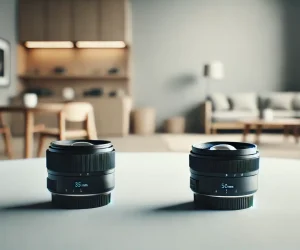
Introduction: What is a Tilt-Shift Lens
Are you wondering what is a Tilt-Shift lens? Well, it is a special camera lens that helps photographers change the plane of focus and perspective in their photos. It’s often used in architectural and landscape photos. This lens also creates the unique look seen in tilt-shift photography, making real scenes look like miniatures.
Fortunately, this is a complete guide to using tilt-shift lenses. We will explain how they work and their benefits. You will also discover different uses, techniques, and common questions. By the end, you will know how to use a tilt-shift lens for various photography needs.
Table of Contents
What Does a Tilt-Shift Lens Do?

This lens has special features that set it apart from regular lenses. It allows photographers to control both proportion and photo focus in unique ways. This capability is particularly useful in tilt-shift photography where specific visual effects are desired.
The Tilt Function
The tilt function of the lens changes the plane of focus. Normally, the plane of focus is parallel to the camera’s sensor. When you tilt the lens, this plane also tilts. This means you can keep objects at different distances in sharp focus.
For example, in landscape photo shoots, tilting the lens helps keep both the foreground and background sharp. If you are capturing a field of flowers with mountains in the background, tilting the lens ensures both the flowers and the mountains are in focus.
The Shift Function
The shift function changes the perspective without moving the camera. This is very useful in architectural photography to keep lines straight and avoid distortion.
When photographing a tall building from the ground, the lines can converge, making the building look like it is falling backward. By shifting the lens upwards, you can correct this and make the lines straight.
Combining Tilt and Shift
Combining both tilt and shift functions gives you more control over your pictures. This is especially useful in complex scenes where you need both clarity control and angle correction. Using the tilt function you can make your product photos look accurate and professional.
How to Use a Tilt-Shift Photography Lens for Creative Results?
Now that you know what is a tilt-shift lens and what it does, you need to learn the essential steps to use it. In tilt-shift photography for beginners, these steps help create striking images.
Steps to Use a Tilt-Shift Lens
- Set Up Your Camera: First, place your camera on a tripod. This keeps your camera steady and makes adjustments easier. A steady camera is crucial for getting clear pictures, especially when using a this lens.
- Level the Camera: Make sure your camera is level. Use a spirit level or your camera’s built-in leveling tool. A level camera helps prevent unwanted distortions in your photos.
- Adjust the Tilt: Use the tilt knob to change the angle of the lens. Start with a small adjustment. For instance, if you are photographing a long fence with trees in the background, adjust the tilt so both the fence and the trees appear clear. This ensures everything you want to be sharp is in focus.
- Adjust the Shift: Use the shift knob to move the lens up, down, or sideways. This helps correct any unwanted distortion. For example, if you are taking a picture of a row of houses, shift the lens to the side to keep the houses' edges straight. This way, the buildings will look natural, not distorted.
- Fine-Tune Focus: After you have adjusted the tilt and shift, check the focus and make small adjustments. Use your camera’s live view to zoom in and ensure everything is clear. This step is important to make sure all parts of your photograph are as clear as possible.
Comparison of Tilt-Shift Lenses
Exploring different types of tilt-shift lenses can help you choose the right one for your needs. Below is a table comparing the features of different camera lenses.
| Feature | Canon TS-E 24mm f/3.5L II | Nikon PC-E 19mm f/4E ED | Canon TS-E 90mm f/2.8L Macro | Laowa 15mm f/4.5 Zero-D Shift |
|---|---|---|---|---|
| Focal Length | 24mm | 19mm | 90mm | 15mm |
| Maximum Aperture | f/3.5 | f/4 | f/2.8 | f/4.5 |
| Tilt Range | ±8.5 degrees | ±7.5 degrees | ±10 degrees | No tilt function |
| Shift Range | ±12mm | ±12mm | ±12mm | ±11mm |
| Rotation | 90 degrees | 90 degrees | 90 degrees | 360 degrees |
| Closest Focus | 0.21m | 0.25m | 0.39m | 0.20m |
| Weight | 780g | 885g | 915g | 770g |
| Filter Thread | 82mm | 77mm | 77mm | 77mm |
| Price Range | High | Very High | High | Moderate |
Tilt-Shift Lenses: Key Benefits
This lens offers many advantages. Knowing what is a tilt-shift lens helps you see why it’s special. Check out these benefits of tilt-shift lenses.
1. Enhanced Depth of Field
These lenses can enhance depth of field in your art. In tilt-shift photography, adjusting the angle changes the clarity. This means both the front and back of a scene can be clear. For example, when taking a picture of a long table set for a feast can show every detail from the nearest plate to the farthest candle.
2. Correcting Perspective Issues
One big benefit of these lenses is fixing perspective issues. This is very useful when you are taking a picture of a tall building from the ground, the verticals often look like they are leaning. By shifting the lens, you can keep these verticals straight, making the building look natural. This also saves time editing your picture using Adobe Photoshop and Lightroom later to ensure accuracy.
3. Creative Effects
4. Versatility in Different Styles
Tilt-shift lenses are versatile tools for different styles of photography. Whether capturing portraits, nature, or buildings, these lenses give you greater control over your shots. This versatility makes these lenses a valuable addition to any photographer’s kit.
Tilt-Shift Lens Settings for Different Photography Types

Understanding what is a tilt-shift lens and its settings can greatly enhance your photos. Each photography type requires different settings for the best results. Below is a table that outlines optimal settings such as aperture, for various types of photography.
| Type | Tilt Setting | Shift Setting | Aperture | Use Case |
|---|---|---|---|---|
| Architecture | Small tilt for depth | Large shift for vertical | f/8 – f/11 | Keeps buildings straight, reduces distortion |
| Landscape | Moderate tilt for depth | Small shift for framing | f/8 – f/16 | Ensures both foreground and background are clear |
| Portraits | Small tilt for focus | Minimal shift | f/2.8 – f/4 | Creates artistic blur, highlights subject |
| Product | Large tilt for focus | Small shift for framing | f/5.6 – f/8 | Keeps entire product in focus, corrects proportion |
| Miniature Effect | Large tilt for effect | Moderate shift | f/2.8 – f/4 | Makes real scenes look like tiny models |
Advanced Uses of Tilt-Shift Lenses
Tilt-shift lenses offer unique creative opportunities. They allow you to capture scenes in ways that standard lenses cannot. Here are some advanced uses that make tilt-shift photography exciting.
Unique Light Effects
This lens can create interesting light effects in your photos. Adjusting the lens can change how light is distributed across the frame. For instance, photographing a scene with bright light sources can result in artistic light flares and patterns. This adds a creative element to your images, making them more visually appealing.
Artistic Frames and Compositions
Panoramic Shots
A tilt-shift lens can also be used to create panoramic photos. By shifting the lens and taking multiple shots, you can stitch them together to form a wide, seamless image. This is particularly useful for capturing wide scenes like cityscapes or vast landscapes.
Macro Photography
These lenses are excellent for macro photography. By adjusting the tilt function, you can keep the entire subject in focus even at very close distances. For example, when photographing small objects like insects, you can achieve a clear and detailed image from front to back. This level of detail is often difficult to achieve with regular lenses.
Disadvantages of Using Tilt-Shift Lenses
While tilt-shift lenses offer many benefits, they also have some drawbacks. Understanding these downsides can help you decide if a tilt-shift lens is right for you.
1. Cost
One of the main disadvantages of tilt-shift lenses is their high cost. These lenses are more expensive than regular lenses. This is because they have special features and complex construction. This makes them a big investment, especially for hobbyists.
2. Learning Curve
Using a tilt-shift lens requires practice and knowledge. These lenses do not have autofocus, so you need to focus manually. Adjusting the tilt and shift functions also takes time to master. For instance, getting the right angle to keep both the foreground and background clear can be tricky. Many beginners may find this frustrating.
3. Weight and Size
Tilt-shift lenses are often heavier and larger than regular lenses. This can make them harder to carry around, especially if you are out for a long day of shooting. The larger size also means it takes up more space in your camera bag, which can be inconvenient for travel photography.
4. Manual Adjustments
Tilt-shift lenses require manual adjustments for each shot. This means you need to take the time to set up each photograph correctly. It also takes more time than using a regular lens. The need for constant adjustments can slow down your shooting process, which is a drawback in fast-paced environments.

Commonly Asked Questions About Tilt-Shift Lenses
A tilt-shift lens is a unique tool, offering powerful capabilities not found in many others. Here, we address some common questions to help you understand what is a tilt-shift lens and how it can enhance your photos.
What is the use of tilt-shift lens?
A tilt-shift lens helps you change the clarity and perspective of a photo. It is often used in tilt-shift photography to make parts of an image clear while other parts are blurry. This lens is also great for making buildings look straight and not distorted when you take pictures of them from the ground.
What is the meaning of tilt-shift?
It refers to two main functions of the lens. “Tilt” means adjusting the lens to change the plane of focus. This helps in keeping different parts of the picture clear. “Shift” means moving the lens up, down, or sideways to change the perspective without moving the camera. This is useful for keeping verticals straight in a photo. Understanding what is a tilt-shift lens helps in seeing why these adjustments are important in creating unique and accurate images.
Is a tilt-shift lens worth it?
This lens is worth it if you need specific effects in your photos. It is especially useful for people who take pictures of buildings, landscapes or want to add unique effects to their images. The lens can be expensive and takes time to learn, but it offers amazing advantages that regular lenses do not.
What is the tilt-shift lens theory?
The tilt-shift lens theory is about how changing the angle and position of the lens affects the image. By tilting the lens, you change the sharpness, which helps keep different parts of the image clear. Shifting the lens changes the angle, which corrects any distortions and keeps verticals straight.
Conclusion
Learning what is a tilt-shift lens can add new dimensions to your photography. I remember my first time using a tilt-shift lens to photograph a city skyline. By adjusting the tilt, I kept both the buildings and the sky clear. It made my picture look incredibly detailed and professional. This experience showed me the power of tilt-shift photography and how it can elevate your work.
If you’re interested in mastering these techniques, consider joining our courses. Our Photoshop Course and Lightroom Course provide comprehensive guides to enhance your skills. Learn how to use tools like tilt-shift lenses to their fullest potential. Start your journey to better images today!
Have a nice photoshoot!
Learn more about Photography Equipment:
Course
Light Effect Photoshop
Lightroom Course 2024
Adobe Photoshop Course
Photo Editing Course
Get the latest version of Photoshop & Lightroom

















